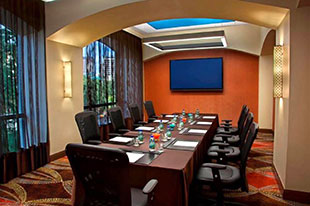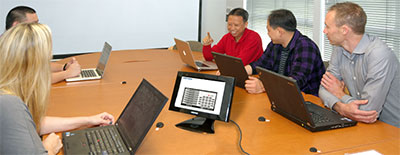![]() The phrase ‘poor relation’ is uncomfortably familiar to most audio professionals. Whether in broadcast, live sound, club installations or even games, the achievements of audio technologies and technicians are regularly obscured by everything from lighting to CGI. Even conferencing systems suffer the same injustice – as elsewhere, audio gets most attention when it fails.
The phrase ‘poor relation’ is uncomfortably familiar to most audio professionals. Whether in broadcast, live sound, club installations or even games, the achievements of audio technologies and technicians are regularly obscured by everything from lighting to CGI. Even conferencing systems suffer the same injustice – as elsewhere, audio gets most attention when it fails.
But conferencing is presently a hot topic – particularly for Symetrix.
No stranger to the broadcast, live sound or installed sound markets, the Seattle-based company has consistently invested heavily in audio signal processing development, moving from the early outboard processing for live sound and recording that it devised in the mid-1990s to today’s advanced DSP systems – its SymNet modular open-architecture network and app-style ‘zero learning curve’ approach to the operation of its Jupiter line of I/O modules.
In technical respects, Symetrix is well set for an entry onto the conference stage. And given the position of established players such as Biamp, DIS, Extron and BSS, the company clearly has business ambitions too – proven by the appointment of Craig Richardson as VP of Global Sales earlier in 2013, described by Symetrix CEO, Paul Roberts as ‘a major player in the world of audio for voice and video conferencing’.

Talking point
As well as taking from areas of audio that preceded its emergence, the conference systems marketplace has contributed a number of its own developments – notably microphone solutions and new DSP capabilities – that reflect its unique requirements. Group conferencing requires audio systems that not only sound good to remote participants, but whose operation is invisible to local participants. Similarly, they must blend as seamlessly as possible into settings ranging from traditional boardrooms to more modern architectural business environments.
Having had five months to learn the specifics of Symetrix’s technologies and intentions, it is time to call Craig Richardson to the rostrum…
‘My background is in the installed conferencing business, product development, engineering management and digital signal processing areas,’ he confirms. ‘I’ve been fortunate to develop, product manage, engineering manage and bring to market at least five different generations of installed audio products – from embeddable acoustic echo cancellers to full-featured multichannel audio DSP systems. My hope is that my background and experience will help ensure we are designing the right products, releasing the right features, communicating the value of our solutions effectively, building demand, showing partners how committed we are about becoming their preferred audio DSP solution provider and making it easy for our partners to learn about and use our solutions.
‘As with many other areas, the key to success in the conferencing market is doing what you say you will do with respect to products and features and being there, unconditionally, for your partners and customers. Fortunately for me, Symetrix has a long history of operating this way too.’
Which only lays the groundwork for the company’s wish to compete for a place in the conferencing market…
‘Symetrix has joined the conferencing market because we have some real value-adds for our partners and end-customers,’ Richardson begins. ‘From an integrator perspective, our solutions are easy to design systems with, and offer an almost unlimited variety of options to help solve their customer’s problems and meet their requirements. Our solutions also natively integrate with third-party devices using Audinate’s Dante audio networking technology, and this also creates an opportunity for distributing systems across an environment. It can also be used to simplify troubleshooting and commissioning.
 ‘In addition, not only do the Symetrix products offer significant performance, they are also quite cost-effective.’
‘In addition, not only do the Symetrix products offer significant performance, they are also quite cost-effective.’
Key among the technologies available to the Symetrix conference agenda are its flagship open-architecture Edge processor and Radius AEC [acoustic echo cancellation] unit – which claims to have the lowest latency for any such unit and offers dedicated AEC on each channel, along with 64x64 Dante networking capability. Radius uses DSP designed specifically for echo cancellation where the output of loudspeakers (typically in-ceiling models installed above the tables in a boardroom) can be picked up by table mics.
‘There are a number of stand-out features of the Symetrix solutions,’ Richardson insists. ‘These include the ability to mix-and-match modular plug-in cards [often termed BYOD – bring your own device] with the SymNet Edge and Radius AEC devices, and removal of audio processing equipment from a room via Dante technology. Fully routable acoustic echo cancellation means that the input to the echo canceller doesn’t have to be on a particular device, and direct outputs make it possible to design custom applications, all with an elegant control protocol.
‘Additionally the modular-plug-in slot on the Radius AEC and the Edge products provides real flexibility to our integration partners, allowing them to create systems that aren’t possible with other solutions and at a price point that is very attractive.’
The emergence of the ‘mass customisation’ model can be stretched to pro audio, if we accept that a product with consistent resources can be shaped to fit varying needs on request. This is eminently possible where products rely on DSP, and can be ‘reshaped’ through the user interface. We are seeing this in digital mixing consoles as well as in Symetrix’s own Jupiter apps. What further developments does Richardson see in the conferencing market?
‘One trend that stands out is that more and more customers are using VoIP [voice-over-internet protocol] for audio conferencing capabilities,’ he offers. ‘Analogue PSTN is harder to find in new and even existing installations, and many of the legacy proprietary digital PBXs are being upgraded to new VoIP-based call management platforms that support SIP [session initiation protocol]. This is happening for a variety of reasons, including security, fidelity and lowering the cost of ownership and use for an organisation.
‘Fortunately SIP makes it possible to associate third-party endpoints – including installed voice solutions – with the call management platform, and to provide at least basic SIP interoperability and primary call features. There are still proprietary extensions of SIP that can bias a customer to a particular brand, but the exposed features make it possible to support the most important call features including dialling, hold, resume, transfer and so on.
‘With the advent of so many useful personal computer collaboration tools, there’s also a need to readily integrate PC audio with a room, so that local participants can hear and be heard regardless of where the audio is coming from or being sent to. Making it easy to integrate with these types of environments is becoming more important.
‘From a manufacturer’s perspective, there’s always room for improvement, both from making the solutions easier to install and providing more opportunities for our partners to add value to installations through customisation of the performance, remote management and monitoring, and finding more interesting applications.
Industry ambitions
 ‘From the industry perspective, there’s always an opportunity to increase awareness around the importance of understanding the customers requirements, providing the right solutions and setting expectations appropriately about what can be achieved in different acoustic environments,’ Richardson continues. ‘Similar to how not all lighting is good for video conferencing, not all rooms are acoustically ready for audio conferencing. It’s important to help our partners and end customers understand what it can take to solve their problems effectively.’
‘From the industry perspective, there’s always an opportunity to increase awareness around the importance of understanding the customers requirements, providing the right solutions and setting expectations appropriately about what can be achieved in different acoustic environments,’ Richardson continues. ‘Similar to how not all lighting is good for video conferencing, not all rooms are acoustically ready for audio conferencing. It’s important to help our partners and end customers understand what it can take to solve their problems effectively.’
The Radius AEC processor is Symetrix’s first dedicated conferencing product – and further proof of the weight of its ambitions. What makes it different from other DSP systems in a crowded marketplace?
‘The AEC is dedicated,’ Richardson begins. ‘This means it’s guaranteed to be there and doesn’t chew up general DSP resources. The AEC also has the lowest latency in the industry – 11ms when active. This means you can use AEC processed signals for local reinforcement without distraction.
‘The AEC is routable,’ he continues. ‘You do not need to process the mic plugged into a specific AEC input; instead you may use remote mics from another box or Dante source. When you choose to do this, you do not lose your local input, as its direct signal is still available for use for other sources. And each channel of AEC has its own Reference input. This allows you to accommodate any combination of submixing, mix-minus and other complex scenarios. Finally, noise cancellation, high-pass filtering and AGC [automatic gain control] are all included on the AEC inputs, which helps maximise AEC performance and voice intelligibility.’
And what of Dante? Its ongoing adoption in a wide spread of audio applications would seem to offer ready interconnection and also erode the relative merits of different manufacturers’ offerings.
‘Not all the players have Dante,’ Richrdson replies. ‘Extron’s Dante capacity is limited. We do 64x64, while they do what appears to be 56x16, but you have to sacrifice your eight virtual buses to get those 16 outputs, and it’s not clear if all 56 inputs can be Dante or a mixture of Dante and their proprietary bus. Quite tricky...
‘Biamp does not do Dante at all, instead relying on CobraNet or AVB. CobraNet is not a managed protocol, so it must be isolated on its own network. AVB does not work with off-the-shelf switches, and there is no third-party interoperability. BSS has all three bus flavours plus a proprietary bus. Very frustrating and confusing for customers deciding what to use, or attempting to augment an existing installation. Plus, integrators are telling us that their Dante implementation isn’t the easiest. You must set up your busing in each unit using their design software, and then you must connect the boxes (initiate the Dante routes) using Dante Controller. We manage everything within our design software and don’t require Dante Controller at all.
‘Sure, there are trade-offs with Dante, but we think it’s the best networking solution around at the moment, and we’ve worked hard to perfect its integration into our product line.’
Any other business…
 As with any aspect of pro audio, training and education in the conferencing sector are becoming more necessary and more critical.
As with any aspect of pro audio, training and education in the conferencing sector are becoming more necessary and more critical.
‘Training and education ensure the new products and technologies are used appropriately,’ Richardson agrees. ‘But many integrators just can’t spend the time to get all the training they need to use the products in the way they want to use them. As manufacturers, we need to make products easier to get up and running, and also easier for our partners to learn the additional material to really customise the behaviour and reach higher performance levels of the products. The partners that do spend the time often are able to recoup their investment many times over, as their expertise allows them to accomplish projects that others wouldn’t have been able to do, or to complete projects in less time, or sometimes both.
‘Symetrix has a number of online training courses and resources about how to use our products effectively. In addition, we regularly spend time at InfoComm educating partners on how to use our solutions and also how to design, install and troubleshoot conferencing solutions in general.
‘Symetrix has a great reputation for audio fidelity, high-quality products and fanatical technical support – characteristics that make it much easier for us to become the go-to DSP audio solution for conferencing applications, in addition to our traditional sound management applications,’ Richardson says.
See also Craig Richardson (appointment)
More: www.symetrix.co